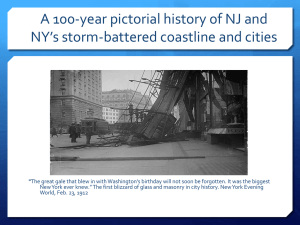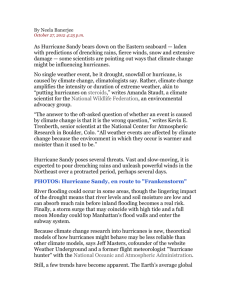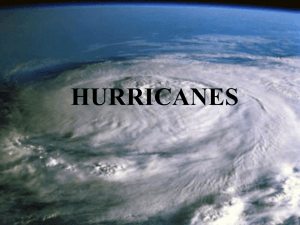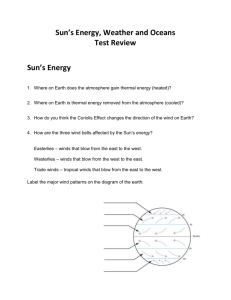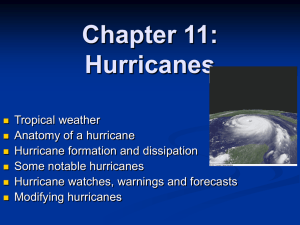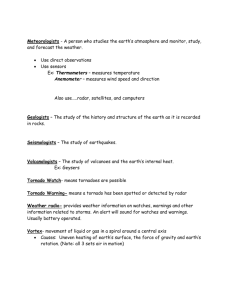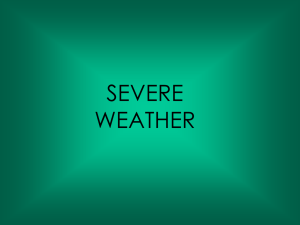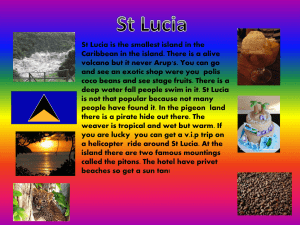Hurricanes Worksheet
advertisement
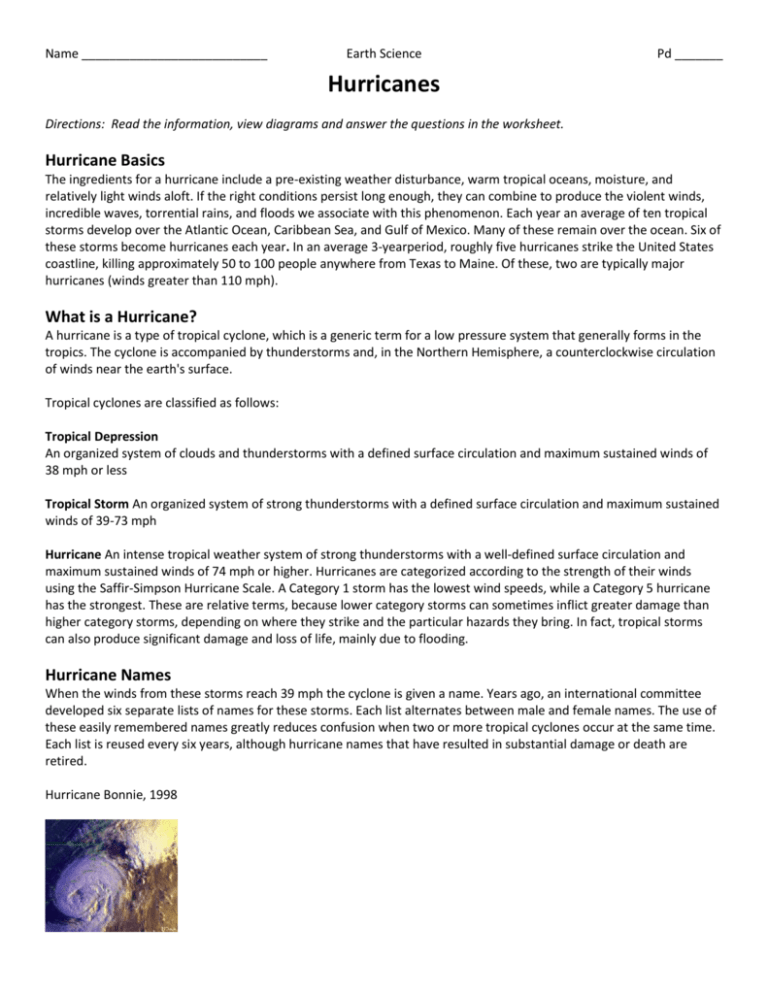
Name ___________________________ Earth Science Pd _______ Hurricanes Directions: Read the information, view diagrams and answer the questions in the worksheet. Hurricane Basics The ingredients for a hurricane include a pre-existing weather disturbance, warm tropical oceans, moisture, and relatively light winds aloft. If the right conditions persist long enough, they can combine to produce the violent winds, incredible waves, torrential rains, and floods we associate with this phenomenon. Each year an average of ten tropical storms develop over the Atlantic Ocean, Caribbean Sea, and Gulf of Mexico. Many of these remain over the ocean. Six of these storms become hurricanes each year. In an average 3-yearperiod, roughly five hurricanes strike the United States coastline, killing approximately 50 to 100 people anywhere from Texas to Maine. Of these, two are typically major hurricanes (winds greater than 110 mph). What is a Hurricane? A hurricane is a type of tropical cyclone, which is a generic term for a low pressure system that generally forms in the tropics. The cyclone is accompanied by thunderstorms and, in the Northern Hemisphere, a counterclockwise circulation of winds near the earth's surface. Tropical cyclones are classified as follows: Tropical Depression An organized system of clouds and thunderstorms with a defined surface circulation and maximum sustained winds of 38 mph or less Tropical Storm An organized system of strong thunderstorms with a defined surface circulation and maximum sustained winds of 39-73 mph Hurricane An intense tropical weather system of strong thunderstorms with a well-defined surface circulation and maximum sustained winds of 74 mph or higher. Hurricanes are categorized according to the strength of their winds using the Saffir-Simpson Hurricane Scale. A Category 1 storm has the lowest wind speeds, while a Category 5 hurricane has the strongest. These are relative terms, because lower category storms can sometimes inflict greater damage than higher category storms, depending on where they strike and the particular hazards they bring. In fact, tropical storms can also produce significant damage and loss of life, mainly due to flooding. Hurricane Names When the winds from these storms reach 39 mph the cyclone is given a name. Years ago, an international committee developed six separate lists of names for these storms. Each list alternates between male and female names. The use of these easily remembered names greatly reduces confusion when two or more tropical cyclones occur at the same time. Each list is reused every six years, although hurricane names that have resulted in substantial damage or death are retired. Hurricane Bonnie, 1998 Name ___________________________ Earth Science Pd _______ 1. What conditions are necessary for a hurricane to form? 2. On average, how many hurricanes form each year? 3. Which direction do hurricanes rotate? 4. What factor determines whether a storm is considered a tropical depression, tropical storm, or hurricane? 5. What is the name of the scale used to measure hurricane strength and what is the range of that scale? 6. How do hurricanes receive their names? Hurricane Structure Contrary to how many weather maps appear, a hurricane is more than a point on a weather map, and its path is more than a line. It is a large system that can affect a wide area, requiring that precautions be taken far from where the eye is predicted to come ashore. The main parts of a hurricane are the rainbands on its outer edges, the eye, and the eyewall. Air spirals in toward the center in a counter-clockwise pattern, and out the top in the opposite direction. In the very center of the storm, air sinks, forming the cloud-free eye. Name ___________________________ Earth Science Pd _______ The Eye The hurricane's center is a relatively calm, clear area usually 20-40 miles across. People in the midst of a hurricane are often amazed at how the incredibly fierce winds and rain can suddenly stop and the sky clear when the eye comes over them. Then, just as quickly, the winds and rain begin again, but this time from the opposite direction. The Eyewall The dense wall of thunderstorms surrounding the eye has the strongest winds within the storm. Changes in the structure of the eye and eyewall can cause changes in the wind speed, which is an indicator of the storm's intensity. The eye can grow or shrink in size, and double (concentric) eyewalls can form. The Spiral Rainbands The storm's outer rainbands (often with hurricane or tropical storm-force winds) can extend a few hundred miles from the center. Hurricane Andrew's (1992) rainbands reached only 100 miles out from the eye, while those in Hurricane Gilbert (1988) stretched over 500 miles. These dense bands of thunderstorms, which spiral slowly counterclockwise, range in width from a few miles to tens of miles and are 50 to 300 miles long. Sometimes the bands and the eye are obscured by higher level clouds, making it difficult for forecasters to use satellite imagery to monitor the storm. 7. Where are the calmest winds in a hurricane located? 8. Where are the strongest winds in a hurricane located? 9. How wide and long are spiral rainbands? Hurricane Hazards The main hazards associated with tropical cyclones and especially hurricanes are storm surge, high winds, heavy rain, and flooding, as well as tornadoes. The intensity of a hurricane is an indicator of damage potential. However, impacts are a function of where and when the storm strikes. Hurricane Diane (1955) hit the northeastern U.S. and caused 184 deaths. It was only a Category 1 hurricane but the thirteenth deadliest since 1900. Hurricane Agnes (1972), also a Category 1 hurricane, ranks fifth with damages estimated at 6.9 billion when adjusted for inflation1 Name ___________________________ Earth Science Pd _______ Storm Surge Storm surge is the greatest potential threat to life and property associated with hurricanes. A storm surge is a large dome of water, 50 to 100 miles wide, that sweeps across the coastline near where a hurricane makes landfall. It can be more than 15 feet deep at its peak. The level of surge in a particular area is primarily related to the intensity of the hurricane and slope of the continental shelf. The Sea, Lake, and Overland Surges from Hurricanes (SLOSH) model is used by communities to evaluate storm surge threat from different categories of hurricanes striking from various directions. Because storm surge has the greatest potential to kill more people than any of the other hurricane hazards, it is wise to err on the conservative side by planning for a storm that is one category more intense than is forecast. High Winds Typically, the more intense the storm (in terms of the Saffir-Simpson Hurricane Scale), the more wind damage a community will sustain, particularly if it does not have an effective mitigation program and has not prepared in advance for the storm. Tropical storm-force winds (39-73 mph) can also be dangerous, and it is wise to have evacuations completed before they reach your area. Heavy Rains Hurricanes (and some tropical storms) typically produce widespread rainfall of 6 to 12 inches or more, often resulting in severe flooding. Inland flooding has been the primary cause of tropical cyclone-related fatalities over the past 30 years. Rains are generally heaviest with slower moving storms (less than 10 mph). The heaviest rain usually occurs to the right of the cyclone track in the period 6 hours before and 6 hours after landfall. However, storms can last for days, depending on what inland weather features they interact with. Large amounts of rain can occur more than 100 miles inland where flash floods and mudslides are typically the major threats. 10. What five aspects of a hurricane can potentially cause damage? 11. Does hurricane strength always determine how much damage is caused? Explain. 12. What is storm surge? What type of damage can it cause? 13. What aspect of a hurricane determines how much rain will fall? 14. Between Storm Surge, High Wind and Heavy Rains which one is the most dangerous? Explain. Name ___________________________ Earth Science Pd _______ Saffir-Simpson Hurricane Scale CATEGORY ONE: Winds 74-95 mph: No real damage to building structures, Damage primarily to unanchored mobile homes, shrubbery, and trees. Also, some coastal road flooding and minor pier damage. CATEGORY TWO: Winds 96-110 mph: Some roofing material, door, and window damage to buildings. Considerable damage to vegetation, mobile homes, and piers. Small craft in unprotected anchorages break moorings. CATEGORY THREE: Winds 111-130 mph: Some structural damage to small residences and utility buildings with a minor amount of curtainwall failures, Mobile homes are destroyed. Flooding near the coast destroys smaller structures with larger structures damaged by floating debris. Terrain may be flooded well inland. CATEGORY FOUR: Winds 131-155 mph: More extensive curtainwall failures with some complete roof structure failure on small residences. Major erosion of beach areas. Major damage to lower floors of structures near the shore Terrain may be flooded well inland. CATEGORY FIVE: Winds greater than 155 mph: Complete roof failure on many residences and industrial buildings. Some complete building failures with small utility buildings blown over or away. Major damage to lower floors of all structures located near the shoreline. Massive evacuation of residential areas may be required. 15. What are the similarities between the Enhanced Fujita Scale and the Saffir-Simposon Hurricane Scale? Explain the differences?


